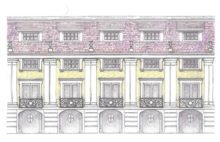
By JOHN T. WARD

On a unanimous vote, the zoning board granted Rapcavage variances for 18 homes fronted by an English garden on Harding Road between Clay Street and Hudson Avenue.
But he’s not yet clear to start work.


With those variances in hand, Rapcavage would return to the board at a later date for site plan review and, in all likelihood, additional variances, said his attorney, Armen McOmber.
But without the use variances, there would be no point in Rapcavage investing additional funds into engineering plans, he said, noting that his client has already spent hundreds of thousands of dollars to remediate contamination on a portion of the site that was long home to a gas station.
The new proposal represented a significant makeover from the one that was rejected as “too dense” by the board last December, McOmber said. That one called for 22 homes, with a total floor area of some 42,000 square feet. The new one, dubbed Azalea Gardens, calls for 33,500 square feet, he said.
“Virtually half of the site is going to be dedicated to open space,” McOmber told the board.
With an audience of about 10 residents present, Rapcavage planner Elizabeth Waterbury said the plan equates to 20 units per acre in a zone where 25 per acre are allowed.
She noted that the Rapcavage property sits at a convergence of roads that bring visitors into town from the east and south, “so when they’re coming into town, this is their view of Red Bank.” Under present zoning laws, she said, Rapcavage could build almost 60,000 square feet of commercial uses on the site without having to obtain any variances.
The townhouse plan, she said, serves as a “transitional use” between the retail businesses along Broad Street and the single-family homes along Hudson, Harding Road and Elm Place.
Waterbury told the board that the plan would eliminate six existing driveways on Hudson Avenue by putting all the parking on the Clay Street side of the project, which faces commercial uses. Each unit would have a two-car garage at grade level beneath three floors of living space, with an additional dedicated space in front of the garage and a space to be shared with a neighbor.
The plan won over not only the board but Anthony Sposaro, a Hudson Avenue resident and land-use lawyer who serves as zoning board attorney in three New Jersey towns. Sposaro opposed the plan of a year ago, he said Thursday, and was leery when Rapcavage called him afterward, asking to meet and talk.
“I viewed him as something of a slumlord,” Sposaro told the board. But he met with Rapcavage several times, even touring a Morris County project similar to the one now under consideration, and “over time, Ray earned my respect and my trust.”
“I can say with a clear conscience that I think this is an outstanding plan,” he added, calling out the garden, which offers a setback of almost 70 feet from Hudson Avenue.
No one in the audience or on the board raised any objections to the plan. Board member Ray Mass, who made the motion for approval, praised Rapcavage “for listening to the zoning board and to the residents” in reimagining his plan.
Rapcavage told redbankgreen afterward that the board’s rejection a year ago “made us rethink the entire site, and oddly enough, had they not denied us, this new plan would have never materialized.”
He said he expects to return to the board as early as next month, if its schedule allows, for site plan approval. Among the issues to be decided is the placement of two affordable units in a project McOmber said would otherwise be “high-end” in price.





















